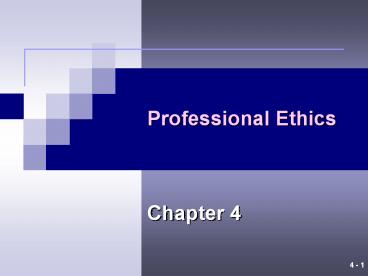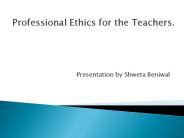Professional Ethics - PowerPoint PPT Presentation
1 / 30
Title:
Professional Ethics
Description:
Professional Ethics Chapter 4 Key Topics in Chapter 4 AICPA Code of Professional Conduct Rule 101, Independence Rules 301, 302, 501, 503 Sarbanes-Oxley Act and SEC ... – PowerPoint PPT presentation
Number of Views:2148
Avg rating:3.0/5.0
Title: Professional Ethics
1
Professional Ethics
- Chapter 4
2
Key Topics in Chapter 4
- AICPA Code of Professional Conduct
- Rule 101, Independence
- Rules 301, 302, 501, 503
- Sarbanes-Oxley Act and SEC Provisions Addressing
Auditor Independence
3
Special Need for Ethical Conduct in Professions
Our society has attached a special meaning to
the term professional.
A professional is expected to conduct himself or
herself at a higher level than most other members
of society.
Trustworthiness and a strong sense of ethics are
assets of the CPA.
4
AICPA Code of Professional Conduct
5
AICPA Code of Professional Conduct
Published explanations and answers to questions
about the rules of conduct submitted to the AICPA
by practitioners and others interested in ethical
requirements. They are not enforceable, but
a practitioner must justify departure.
Ethical rulings
6
Who Falls Under the AICPA Rules of Conduct (Code)?
- Technically, members of the AICPA.
- However, state and federal courts have held that
all practicing CPAs must follow ethical
standards, as set forth in the Code of
Professional Conduct.
7
Standards of Conduct
8
Independence
The value of auditing depends heavily on the
publics perception of the independence of
auditors.
- Independence in fact, means the member must be
unbiased and objective mentally it is a state
of mind. - Independence in in appearance means that
knowledgeable users of financial statements must
believe the auditor is independent avoiding
observable conflicts of interest
9
AICPA Rules of Conduct
Rule 101 Independence
A member in public practice shall be independent
in the performance of professional services as
required by standards promulgated by
bodies designated by Council.
10
Financial Interests
Interpretations of Rule 101 prohibit covered
members from owning any direct investments in
audit clients.
Covered members
Direct versus indirect financial interest
Material or immaterial
11
Engagement Based Approach
- Covered members are persons in a position with
the potential to influence audit decisions,
including - Individuals on engagement team.
- Individuals who supervise or evaluate the
engagement partner. - Partners who provide non-attest services to the
client. - Refer to p. 86 of chapter for others.
12
Prohibited Activities by Covered Members
- Members cannot
- Have a direct or material indirect investment in
the audit client. - Be a director, officer, manager, or employee of
the client. - Participate in joint business ventures with the
client. - Have loans to or from the client.
- Automobile loans and leases
- Collateralized loans
- Credit cards and cash advances
13
Related FinancialInterests Issues
- Former practitioners
- Normal lending procedures
- Financial interests and employment
- of immediate and close family
- Joint investor or investee
- relationship with client
- Director, officer, management,
- or employee of a company
14
Litigation Between CPA Firmand Client
A lawsuit or intent to start a lawsuit between a
CPA firm and its client is a violation of Rule
101 for the current audit.
15
Bookkeeping
- The AICPA Code permits a CPA firm
- to do both bookkeeping and auditing
- for the same client.
- See p. 89.
- Note that SOX takes a different
- position with publicly traded (SEC)
- clients, p. 83.
16
Other Services and Unpaid Fees
- Consulting and other nonaudit services
- Must avoid performing management functions
- Note that SOX takes a different
- position with publicly traded (SEC)
- clients, p. 83
- Unpaid fees
- Can cause a conflict of interest if they
- relate to professional services provided
- more than one year prior to the date of
- the report
17
Rule 301 Confidential client information
- Generally, a member may not disclose any
confidential client information without the
specific consent of the client. - Exceptions
- Obligations related to technical standards
- Subpoena or summons
- Peer review
- Response to ethics division
18
Rule 302 Contingent fees
- Contingent fees for any professional services are
generally prohibited when - (1) a member (or firm) performs
- (a) an audit or review of financial statements
or - (b) a compilation of a financial statement (see
text) - (c) an examination of prospective financial
information or - (2) Prepare an original or amended tax return or
claim for a tax refund for a contingent fee for
any client.
19
Rule 501 Acts discreditable
- A member shall not commit an act discreditable to
the profession, including - Retention of client records.
- Discrimination and harassment in employment
practices. - Failure to follow standards and/or procedures or
other requirements in governmental audits. - Negligence in the preparation of financial
statements or records. - Failure to follow requirements of governmental
bodies, commissions, or other regulatory agencies
in performing attest or similar services. - Solicitation or disclosure of CPA examination
questions and answers. - Failure to file tax return or pay tax liability.
20
Rule 503 Commissions and referral fees
- Commissions are not allowed when a member or the
member's firm also performs for that client - An audit or review of financial statements or
- A compilation of a financial statement (see text)
or - An examination of prospective financial
information. - Disclosure of permitted commissions or referral
fees.
21
Other AICPA Rules of Conduct
- 102 Integrity and objectivity
- 201 General standards
- 202 Compliance with standards
- 203 Accounting principles
- 502 Advertising and other forms
- of solicitation
- 505 Form of organization and name
22
Enforcement mechanisms for the rules of conduct
- Action by AICPA
- Remedial or corrective action
- Expulsion and notification to that effect in
- the CPA Newsletter
- Action by a state Board of Accountancy
- Varies by state, but license may be
- revoked.
23
Sarbanes-Oxley Act and SEC Provisions Addressing
Auditor Independence
The SEC adopted rules strengthening
auditor independence in January 2003 Consistent
with the requirements of the Sarbanes-Oxley Act.
The Sarbanes-Oxley Act and the revised SEC rules
further restrict, but do not completely eliminate
the type of nonaudit services that can be
provided to the public.
24
Who Falls Under the SEC Provisions for Auditor
Independence?
- Auditors of publicly traded companies.
25
Sarbanes-Oxley Act and SEC Provisions Addressing
Auditor Independence
Prohibited Services
1. Bookkeeping and other accounting services 2.
Financial information systems design and
implementation 3. Appraisal or valuation
services 4. Actuarial services 5. Internal audit
outsourcing 6. Management of human resource
functions 7. Broker or dealer or investment
adviser or investment banker services 8.
Legal and expert services unrelated to the
audit 9. Any other service that the PCAOB
determines by regulation is impermissible
26
Audit Committees
- An audit committee is a selected number
- of members of a companys board of directors
- whose responsibilities include helping
- auditors remain independent of management.
- Duties include
- Pre-approval of all audit and nonaudit services
- Oversight of auditors work
- Resolution of disagreements between management
- and auditors
27
Audit Committees
The Sarbanes-Oxley Act requires that all members
of the audit committee be independent.
Companies must disclose whether or not the audit
committee includes at least one financial expert.
28
Conflicts Arising from Employment Relationships
- The SEC has added a one year cooling off
- period before a member of the audit
- engagement team can work for the
- client in certain key management positions.
- Chief Executive Officer
- Chief Financial Officer
- Chief Accounting Officer
- Equivalent positions to the above
29
Partner Rotation
The Sarbanes-Oxley Act requires that the lead and
concurring audit partner rotate off the audit
engagement after a period of five years.
30
Ownership Interests
- SEC rules adopted in 2000 on financial
- relationships narrow the restrictions on
- ownership in clients to those persons
- who can influence the audit.
- Members of the engagement team
- Those in a position to influence audit
- engagement
- Partners and managers providing
- gt10 hrs of non-audit svcs. to client
- Partners in the office of the partner
- primarily responsible for engagement































